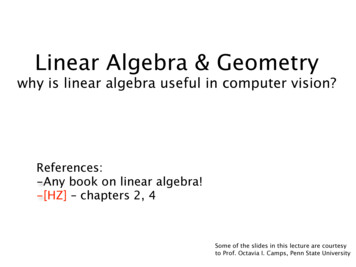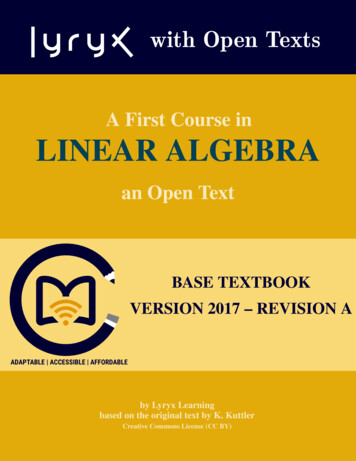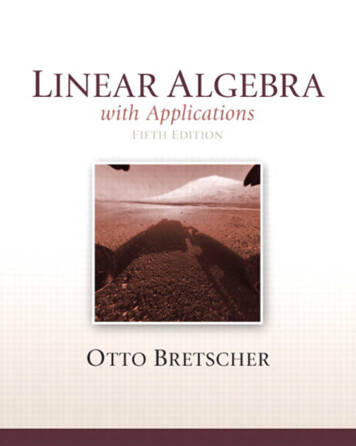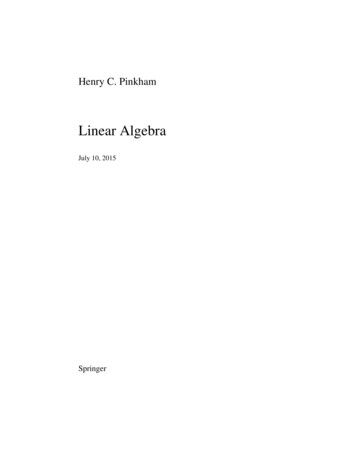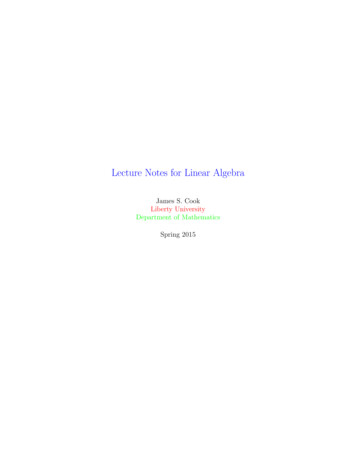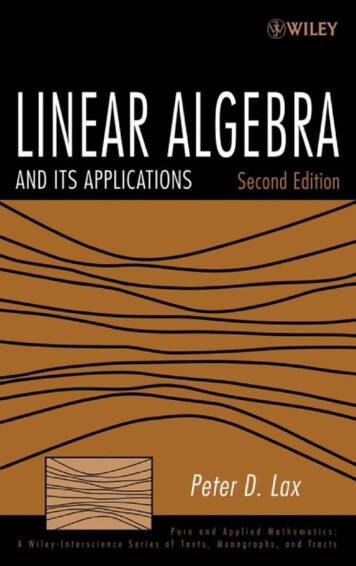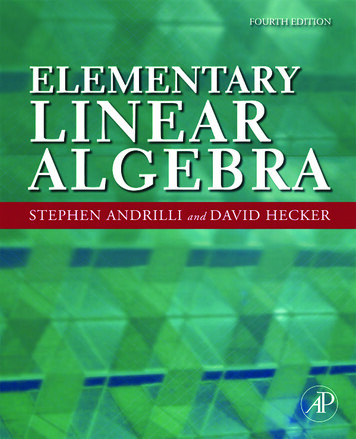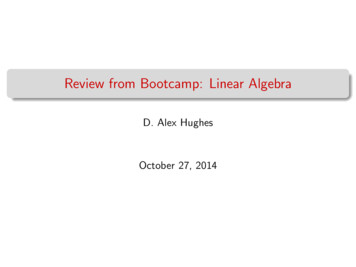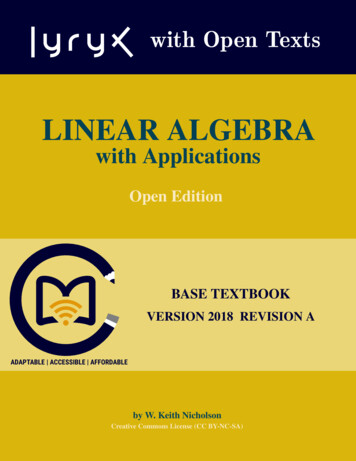
Transcription
with Open TextsLINEAR ALGEBRAwith ApplicationsOpen EditionBASE TEXTBOOKVERSION 2018 REVISION AADAPTABLE ACCESSIBLE AFFORDABLEby W. Keith NicholsonCreative Commons License (CC BY-NC-SA)
a dv a ncin gl ea rn i n gChampions of Access to KnowledgeONLINEASSESSMENTOPEN TEXTAll digital forms of access to our high-qualityopen texts are entirely FREE! All content isreviewed for excellence and is wholly adaptable; custom editions are produced by Lyryxfor those adopting Lyryx assessment. Accessto the original source files is also open to anyone!We have been developing superior online formative assessment for more than 15 years. Ourquestions are continuously adapted with thecontent and reviewed for quality and soundpedagogy. To enhance learning, students receive immediate personalized feedback. Student grade reports and performance statisticsare also provided.INSTRUCTORSUPPLEMENTSSUPPORTAccess to our in-house support team is available 7 days/week to provide prompt resolutionto both student and instructor inquiries. In addition, we work one-on-one with instructors toprovide a comprehensive system, customizedfor their course. This can include adapting thetext, managing multiple sections, and more!Additional instructor resources are also freelyaccessible. Product dependent, these supplements include: full sets of adaptable slides andlecture notes, solutions manuals, and multiplechoice question banks with an exam buildingtool.Contact Lyryx Today!info@lyryx.com
a dv a ncin gl ea rn i n gLinear Algebra with ApplicationsOpen EditionBE A CHAMPION OF OPEN EDUCATIONAL RESOURCES!Contribute suggestions for improvements, new content, or errata:A new topicA new exampleAn interesting new questionA new or better proof to an existing theoremAny other suggestions to improve the materialContact Lyryx at info@lyryx.com with your ideas.CONTRIBUTIONSAuthorW. Keith Nicholson, University of CalgaryLyryx Learning TeamBruce BauslaughPeter ChowNathan FriessStephanie KeyowskiClaude LaflammeMartha LaflammeJennifer MacKenzieTamsyn MurnaghanBogdan SavaRyan YeeLICENSECreative Commons License (CC BY-NC-SA): This text, including the art and illustrations, are availableunder the Creative Commons license (CC BY-NC-SA), allowing anyone to reuse, revise, remix andredistribute the text.To view a copy of this license, visit http://creativecommons.org/licenses/by-nc-sa/4.0/
Contents1 Systems of Linear Equations11.11.2Solutions and Elementary Operations . . . . . . . . . . . . . . . . . . . . . . . . . . . . 1Gaussian Elimination . . . . . . . . . . . . . . . . . . . . . . . . . . . . . . . . . . . . . 101.31.41.5Homogeneous Equations . . . . . . . . . . . . . . . . . . . . . . . . . . . . . . . . . . . 21An Application to Network Flow . . . . . . . . . . . . . . . . . . . . . . . . . . . . . . . 28An Application to Electrical Networks . . . . . . . . . . . . . . . . . . . . . . . . . . . . 311.6 An Application to Chemical Reactions . . . . . . . . . . . . . . . . . . . . . . . . . . . . 33Supplementary Exercises for Chapter 1 . . . . . . . . . . . . . . . . . . . . . . . . . . . . . . . 352 Matrix Algebra372.12.2Matrix Addition, Scalar Multiplication, and Transposition . . . . . . . . . . . . . . . . . . 37Equations, Matrices, and Transformations . . . . . . . . . . . . . . . . . . . . . . . . . . 492.32.4Matrix Multiplication . . . . . . . . . . . . . . . . . . . . . . . . . . . . . . . . . . . . . 66Matrix Inverses . . . . . . . . . . . . . . . . . . . . . . . . . . . . . . . . . . . . . . . . 832.52.62.7Elementary Matrices . . . . . . . . . . . . . . . . . . . . . . . . . . . . . . . . . . . . . 100Linear Transformations . . . . . . . . . . . . . . . . . . . . . . . . . . . . . . . . . . . . 109LU-Factorization . . . . . . . . . . . . . . . . . . . . . . . . . . . . . . . . . . . . . . . 1232.82.9An Application to Input-Output Economic Models . . . . . . . . . . . . . . . . . . . . . 134An Application to Markov Chains . . . . . . . . . . . . . . . . . . . . . . . . . . . . . . 139Supplementary Exercises for Chapter 2 . . . . . . . . . . . . . . . . . . . . . . . . . . . . . . . 1493 Determinants and Diagonalization1513.1 The Cofactor Expansion . . . . . . . . . . . . . . . . . . . . . . . . . . . . . . . . . . . 1513.23.3Determinants and Matrix Inverses . . . . . . . . . . . . . . . . . . . . . . . . . . . . . . 165Diagonalization and Eigenvalues . . . . . . . . . . . . . . . . . . . . . . . . . . . . . . . 1793.43.53.6An Application to Linear Recurrences . . . . . . . . . . . . . . . . . . . . . . . . . . . . 201An Application to Systems of Differential Equations . . . . . . . . . . . . . . . . . . . . 207Proof of the Cofactor Expansion Theorem . . . . . . . . . . . . . . . . . . . . . . . . . . 213Supplementary Exercises for Chapter 3 . . . . . . . . . . . . . . . . . . . . . . . . . . . . . . . 2174 Vector Geometry2194.1 Vectors and Lines . . . . . . . . . . . . . . . . . . . . . . . . . . . . . . . . . . . . . . . 219iii
ivCONTENTS4.24.3Projections and Planes . . . . . . . . . . . . . . . . . . . . . . . . . . . . . . . . . . . . 236More on the Cross Product . . . . . . . . . . . . . . . . . . . . . . . . . . . . . . . . . . 2564.4 Linear Operators on R3 . . . . . . . . . . . . . . . . . . . . . . . . . . . . . . . . . . . . 2624.5 An Application to Computer Graphics . . . . . . . . . . . . . . . . . . . . . . . . . . . . 270Supplementary Exercises for Chapter 4 . . . . . . . . . . . . . . . . . . . . . . . . . . . . . . . 2735 Vector Space Rn2755.15.2Subspaces and Spanning . . . . . . . . . . . . . . . . . . . . . . . . . . . . . . . . . . . 275Independence and Dimension . . . . . . . . . . . . . . . . . . . . . . . . . . . . . . . . . 2835.35.4Orthogonality . . . . . . . . . . . . . . . . . . . . . . . . . . . . . . . . . . . . . . . . . 294Rank of a Matrix . . . . . . . . . . . . . . . . . . . . . . . . . . . . . . . . . . . . . . . 3035.55.6Similarity and Diagonalization . . . . . . . . . . . . . . . . . . . . . . . . . . . . . . . . 311Best Approximation and Least Squares . . . . . . . . . . . . . . . . . . . . . . . . . . . . 3245.7 An Application to Correlation and Variance . . . . . . . . . . . . . . . . . . . . . . . . . 336Supplementary Exercises for Chapter 5 . . . . . . . . . . . . . . . . . . . . . . . . . . . . . . . 3416 Vector Spaces3436.1 Examples and Basic Properties . . . . . . . . . . . . . . . . . . . . . . . . . . . . . . . . 3436.26.3Subspaces and Spanning Sets . . . . . . . . . . . . . . . . . . . . . . . . . . . . . . . . . 352Linear Independence and Dimension . . . . . . . . . . . . . . . . . . . . . . . . . . . . . 3606.46.5Finite Dimensional Spaces . . . . . . . . . . . . . . . . . . . . . . . . . . . . . . . . . . 369An Application to Polynomials . . . . . . . . . . . . . . . . . . . . . . . . . . . . . . . . 3776.6 An Application to Differential Equations . . . . . . . . . . . . . . . . . . . . . . . . . . . 382Supplementary Exercises for Chapter 6 . . . . . . . . . . . . . . . . . . . . . . . . . . . . . . . 3887 Linear Transformations3897.17.27.3Examples and Elementary Properties . . . . . . . . . . . . . . . . . . . . . . . . . . . . . 389Kernel and Image of a Linear Transformation . . . . . . . . . . . . . . . . . . . . . . . . 396Isomorphisms and Composition . . . . . . . . . . . . . . . . . . . . . . . . . . . . . . . 4067.47.5A Theorem about Differential Equations . . . . . . . . . . . . . . . . . . . . . . . . . . . 417More on Linear Recurrences . . . . . . . . . . . . . . . . . . . . . . . . . . . . . . . . . 4208 Orthogonality4298.18.2Orthogonal Complements and Projections . . . . . . . . . . . . . . . . . . . . . . . . . . 429Orthogonal Diagonalization . . . . . . . . . . . . . . . . . . . . . . . . . . . . . . . . . . 4388.38.4Positive Definite Matrices . . . . . . . . . . . . . . . . . . . . . . . . . . . . . . . . . . . 448QR-Factorization . . . . . . . . . . . . . . . . . . . . . . . . . . . . . . . . . . . . . . . 4538.5Computing Eigenvalues . . . . . . . . . . . . . . . . . . . . . . . . . . . . . . . . . . . . 457
CONTENTS8.68.7vComplex Matrices . . . . . . . . . . . . . . . . . . . . . . . . . . . . . . . . . . . . . . . 461An Application to Linear Codes over Finite Fields . . . . . . . . . . . . . . . . . . . . . . 4738.8 An Application to Quadratic Forms . . . . . . . . . . . . . . . . . . . . . . . . . . . . . 4878.9 An Application to Constrained Optimization . . . . . . . . . . . . . . . . . . . . . . . . . 4988.10 An Application to Statistical Principal Component . . . . . . . . . . . . . . . . . . . . . 5019 Change of Basis5039.19.2The Matrix of a Linear Transformation . . . . . . . . . . . . . . . . . . . . . . . . . . . . 503Operators and Similarity . . . . . . . . . . . . . . . . . . . . . . . . . . . . . . . . . . . 5139.3Invariant Subspaces and Direct Sums . . . . . . . . . . . . . . . . . . . . . . . . . . . . . 52310 Inner Product Spaces53710.1 Inner Products and Norms . . . . . . . . . . . . . . . . . . . . . . . . . . . . . . . . . . 53710.2 Orthogonal Sets of Vectors . . . . . . . . . . . . . . . . . . . . . . . . . . . . . . . . . . 54710.3 Orthogonal Diagonalization . . . . . . . . . . . . . . . . . . . . . . . . . . . . . . . . . . 55810.4 Isometries . . . . . . . . . . . . . . . . . . . . . . . . . . . . . . . . . . . . . . . . . . . 56610.5 An Application to Fourier Approximation . . . . . . . . . . . . . . . . . . . . . . . . . . 57911 Canonical Forms58511.1 Block Triangular Form . . . . . . . . . . . . . . . . . . . . . . . . . . . . . . . . . . . . 58511.2 The Jordan Canonical Form . . . . . . . . . . . . . . . . . . . . . . . . . . . . . . . . . . 593A Complex Numbers599B Proofs615C Mathematical Induction621D Polynomials627Selected Exercise Answers631
ForewardMathematics education at the beginning university level is closely tied to the traditional publishers. In myopinion, it gives them too much control of both cost and content. The main goal of most publishers isprofit, and the result has been a sales-driven business model as opposed to a pedagogical one. This resultsin frequent new “editions” of textbooks motivated largely to reduce the sale of used books rather than toupdate content quality. It also introduces copyright restrictions which stifle the creation and use of newpedagogical methods and materials. The overall result is high cost textbooks which may not meet theevolving educational needs of instructors and students.To be fair, publishers do try to produce material that reflects new trends. But their goal is to sell booksand not necessarily to create tools for student success in mathematics education. Sadly, this has led toa model where the primary choice for adapting to (or initiating) curriculum change is to find a differentcommercial textbook. My editor once said that the text that is adopted is often everyone’s third choice.Of course instructors can produce their own lecture notes, and have done so for years, but this remainsan onerous task. The publishing industry arose from the need to provide authors with copy-editing, editorial, and marketing services, as well as extensive reviews of prospective customers to ascertain markettrends and content updates. These are necessary skills and services that the industry continues to offer.Authors of open educational resources (OER) including (but not limited to) textbooks and lecturenotes, cannot afford this on their own. But they do have two great advantages: The cost to students issignificantly lower, and open licenses return content control to instructors. Through editable file formatsand open licenses, OER can be developed, maintained, reviewed, edited, and improved by a variety ofcontributors. Instructors can now respond to curriculum change by revising and reordering material tocreate content that meets the needs of their students. While editorial and quality control remain dauntingtasks, great strides have been made in addressing the issues of accessibility, affordability and adaptabilityof the material.For the above reasons I have decided to release my text under an open license, even though it waspublished for many years through a traditional publisher.Supporting students and instructors in a typical classroom requires much more than a textbook. Thus,while anyone is welcome to use and adapt my text at no cost, I also decided to work closely with LyryxLearning. With colleagues at the University of Calgary, I helped create Lyryx almost 20 years ago. Theoriginal idea was to develop quality online assessment (with feedback) well beyond the multiple-choicestyle then available. Now Lyryx also works to provide and sustain open textbooks; working with authors,contributors, and reviewers to ensure instructors need not sacrifice quality and rigour when switching toan open text.I believe this is the right direction for mathematical publishing going forward, and look forward tobeing a part of how this new approach develops.W. Keith Nicholson, Authorvii
PrefaceThis textbook is an introduction to the ideas and techniques of linear algebra for first- or second-yearstudents with a working knowledge of high school algebra. The contents have enough flexibility to presenta traditional introduction to the subject, or to allow for a more applied course. Chapters 1–4 contain a onesemester course for beginners whereas Chapters 5–9 contain a second semester course (see the SuggestedCourse Outlines below). The text is primarily about real linear algebra with complex numbers beingmentioned when appropriate (reviewed in Appendix A). Overall, the aim of the text is to achieve a balanceamong computational skills, theory, and applications of linear algebra. Calculus is not a prerequisite;places where it is mentioned may be omitted.As a rule, students of linear algebra learn by studying examples and solving problems. Accordingly,the book contains a variety of exercises (over 1200, many with multiple parts), ordered as to their difficulty.In addition, more than 375 solved examples are included in the text, many of which are computational innature. The examples are also used to motivate (and illustrate) concepts and theorems, carrying the studentfrom concrete to abstract. While the treatment is rigorous, proofs are presented at a level appropriate tothe student and may be omitted with no loss of continuity. As a result, the book can be used to give acourse that emphasizes computation and examples, or to give a more theoretical treatment (some longerproofs are deferred to the end of the Section).Linear Algebra has application to the natural sciences, engineering, management, and the social sciences as well as mathematics. Consequently, 18 optional “applications” sections are included in the textintroducing topics as diverse as electrical networks, economic models, Markov chains, linear recurrences,systems of differential equations, and linear codes over finite fields. Additionally some applications (forexample linear dynamical systems, and directed graphs) are introduced in context. The applications sections appear at the end of the relevant chapters to encourage students to browse.SUGGESTED COURSE OUTLINESThis text includes the basis for a two-semester course in linear algebra. Chapters 1–4 provide a standard one-semester course of 35 lectures, including linear equations, matrix algebra, determinants, diagonalization, and geometric vectors, with applications as time permits.At Calgary, we cover Sections 1.1–1.3, 2.1–2.6, 3.1–3.3, and 4.1–4.4 and the course is taken by allscience and engineering students in their first semester. Prerequisites include a working knowledgeof high school algebra (algebraic manipulations and some familiarity with polynomials); calculus isnot required. Chapters 5–9 contain a second semester course including Rn , abstract vector spaces, linear transformations (and their matrices), orthogonality, complex matrices (up to the spectral theorem) andapplications. There is more material here than can be covered in one semester, and at Calgary weix
xCONTENTScover Sections 5.1–5.5, 6.1–6.4, 7.1–7.3, 8.1–8.6, and 9.1–9.3 with a couple of applications as timepermits. Chapter 5 is a “bridging” chapter that introduces concepts like spanning, independence, and basisin the concrete setting of Rn , before venturing into the abstract in Chapter 6. The duplication isbalanced by the value of reviewing these notions, and it enables the student to focus in Chapter 6on the new idea of an abstract system. Moreover, Chapter 5 completes the discussion of rank anddiagonalization from earlier chapters, and includes a brief introduction to orthogonality in Rn , whichcreates the possibility of a one-semester, matrix-oriented course covering Chapter 1–5 for studentsnot wanting to study the abstract theory.CHAPTER DEPENDENCIESThe following chart suggests how the material introduced in each chapter draws on concepts covered incertain earlier chapters. A solid arrow means that ready assimilation of ideas and techniques presentedin the later chapter depends on familiarity with the earlier chapter. A broken arrow indicates that somereference to the earlier chapter is made but the chapter need not be covered.HIGHLIGHTS OF THE TEXT Two-stage definition of matrix multiplication. First, in Section 2.2 matrix-vector products areintroduced naturally by viewing the left side of a system of linear equations as a product. Second,matrix-matrix products are defined in Section 2.3 by taking the columns of a product AB to be Atimes the corresponding columns of B. This is motivated by viewing the matrix product as composition of maps (see next item). This works well pedagogically and the usual dot-product definitionfollows easily. As a bonus, the proof of associativity of matrix multiplication now takes four lines.
CONTENTSxi Matrices as transformations. Matrix-column multiplications are viewed (in Section 2.2) as transformations Rn Rm . These maps are then used to describe simple geometric reflections and rotations in R2 as well as systems of linear equations. Early linear transformations. It has been said that vector spaces exist so that linear transformationscan act on them—consequently these maps are a recurring theme in the text. Motivated by the matrixtransformations introduced earlier, linear transformations Rn Rm are defined in Section 2.6, theirstandard matrices are derived, and they are then used to describe rotations, reflections, projections,and other operators on R2 . Early diagonalization. As requested by engineers and scientists, this important technique is presented in the first term using only determinants and matrix inverses (before defining independenceand dimension). Applications to population growth and linear recurrences are given. Early dynamical systems. These are introduced in Chapter 3, and lead (via diagonalization) toapplications like the possible extinction of species. Beginning students in science and engineeringcan relate to this because they can see (often for the first time) the relevance of the subject to the realworld. Bridging chapter. Chapter 5 lets students deal with tough concepts (like independence, spanning,and basis) in the concrete setting of Rn before having to cope with abstract vector spaces in Chapter 6. Examples. The text contains over 375 worked examples, which present the main techniques of thesubject, illustrate the central ideas, and are keyed to the exercises in each section. Exercises. The text contains a variety of exercises (nearly 1175, many with multiple parts), startingwith computational problems and gradually progressing to more theoretical exercises. Select solutions are available at the end of the book or in the Student Solution Manual. There is a completeSolution Manual is available for instructors. Applications. There are optional applications at the end of most chapters (see the list below).While some are presented in the course of the text, most appear at the end of the relevant chapter toencourage students to browse. Appendices. Because complex numbers are needed in the text, they are described in Appendix A,which includes the polar form and roots of unity. Methods of proofs are discussed in Appendix B,followed by mathematical induction in Appendix C. A brief discussion of polynomials is includedin Appendix D. All these topics are presented at the high-school level. Self-Study. This text is self-contained and therefore is suitable for self-study. Rigour. Proofs are presented as clearly as possible (some at the end of the section), but they areoptional and the instructor can choose how much he or she wants to prove. However the proofs arethere, so this text is more rigorous than most. Linear algebra provides one of the better venues wherestudents begin to think logically and argue concisely. To this end, there are exercises that ask thestudent to “show” some simple implication, and others that ask her or him to either prove a givenstatement or give a counterexample. I personally present a few proofs in the first semester courseand more in the second (see the Suggested Course Outlines).
xiiCONTENTS Major Theorems. Several major results are presented in the book. Examples: Uniqueness of thereduced row-echelon form; the cofactor expansion for determinants; the Cayley-Hamilton theorem;the Jordan canonical form; Schur’s theorem on block triangular form; the principal axis and spectraltheorems; and others. Proofs are included because the stronger students should at least be aware ofwhat is involved.CHAPTER SUMMARIESChapter 1: Systems of Linear Equations.A standard treatment of gaussian elimination is given. The rank of a matrix is introduced via the rowechelon form, and solutions to a homogenous system are presented as linear combinations of basic solutions. Applications to network flows, electrical networks, and chemical reactions are provided.Chapter 2: Matrix Algebra.After a traditional look at matrix addition, scalar multiplication, and transposition in Section 2.1, matrixvector multiplication is introduced in Section 2.2 by viewing the left side of a system of linear equationsas the product Ax of the coefficient matrix A with the column x of variables. The usual dot-productdefinition of a matrix-vector multiplication follows. Section 2.2 ends by viewing an m n matrix A as atransformation Rn Rm . This is illustrated for R2 R2 by describing reflection in the x axis, rotation ofR2 through π2 , shears, and so on.In Section 2.3, the product of matrices A and B is defined by AB [Ab1 Ab2 . . . Abn ], where the bi arethe columns of B. A routine computation shows that this is the matrix of the transformation B followedby A. This observation is used frequently throughout the book, and leads to simple, conceptual proofs ofthe basic axioms of matrix algebra. Note that linearity is not required—all that is needed is some basicproperties of matrix-vector multiplication developed in Section 2.2. Thus the usual arcane definition ofmatrix multiplication is split into two well motivated parts, each an important aspect of matrix algebra.Of course, this has the pedagogical advantage that the conceptual power of geometry can be invoked toilluminate and clarify algebraic techniques and definitions.In Section 2.4 and 2.5 matrix inverses are characterized, their geometrical meaning is explored, andblock multiplication is introduced, emphasizing those cases needed later in the book. Elementary matrices are discussed, and the Smith normal form is derived. Then in Section 2.6, linear transformationsRn Rm are defined and shown to be matrix transformations. The matrices of reflections, rotations, andprojections in the plane are determined. Finally, matrix multiplication is related to directed graphs, matrixLU-factorization is introduced, and applications to economic models and Markov chains are presented.
CONTENTSxiiiChapter 3: Determinants and Diagonalization.The cofactor expansion is stated (proved by induction later) and used to define determinants inductivelyand to deduce the basic rules. The product and adjugate theorems are proved. Then the diagonalizationalgorithm is presented (motivated by an example about the possible extinction of a species of birds). Asrequested by our Engineering Faculty, this is done earlier than in most texts because it requires only determinants and matrix inverses, avoiding any need for subspaces, independence and dimension. Eigenvectorsof a 2 2 matrix A are described geometrically (using the A-invariance of lines through the origin). Diagonalization is then used to study discrete linear dynamical systems and to discuss applications to linearrecurrences and systems of differential equations. A brief discussion of Google PageRank is included.Chapter 4: Vector Geometry.Vectors are presented intrinsically in terms of length and direction, and are related to matrices via coordinates. Then vector operations are defined using matrices and shown to be the same as the correspondingintrinsic definitions. Next, dot products and projections are introduced to solve problems about lines andplanes. This leads to the cross product. Then matrix transformations are introduced in R3 , matrices of projections and reflections are derived, and areas and volumes are computed using determinants. The chaptercloses with an application to computer graphics.Chapter 5: The Vector Space Rn .Subspaces, spanning, independence, and dimensions are introduced in the context of Rn in the first twosections. Orthogonal bases are introduced and used to derive the expansion theorem. The basic propertiesof rank are presented and used to justify the definition given in Section 1.2. Then, after a rigorous study ofdiagonalization, best approximation and least squares are discussed. The chapter closes with an applicationto correlation and variance.This is a “bridging” chapter, easing the transition to abstract spaces. Concern about duplication withChapter 6 is mitigated by the fact that this is the most difficult part of the course and many studentswelcome a repeat discussion of concepts like independence and spanning, albeit in the abstract setting.In a different direction, Chapter 1–5 could serve as a solid introduction to linear algebra for students notrequiring abstract theory.Chapter 6: Vector Spaces.Building on the work on Rn in Chapter 5, the basic theory of abstract finite dimensional vector spaces isdeveloped emphasizing new examples like matrices, polynomials and functions. This is the first acquaintance most students have had with an abstract system, so not having to deal with spanning, independenceand dimension in the general context eases the transition to abstract thinking. Applications to polynomialsand to differential equations are included.
xivCONTENTSChapter 7: Linear Transformations.General linear transformations are introduced, motivated by many examples from geometry, matrix theory,and calculus. Then kernels and images are defined, the dimension theorem is proved, and isomorphismsare discussed. The chapter ends with an application to linear recurrences. A proof is included that theorder of a differential equation (with constant coefficients) equals the dimension of the space of solutions.Chapter 8: Orthogonality.The study of orthogonality in Rn , begun in Chapter 5, is continued. Orthogonal complements and projections are defined and used to study orthogonal diagonalization. This leads to the principal axis theorem,the Cholesky factorization of a positive definite matrix, and QR-factorization. The theory is extended toCn in Section 8.6 where hermitian and unitary matrices are discussed, culminating in Schur’s theorem andthe spectral theorem. A short proof of the Cayley-Hamilton theorem is also presented. In Section 8.7the field Z p of integers modulo p is constructed informally for any prime p, and codes are discussed overany finite field. The chapter concludes with applications to quadratic forms, constrained optimization, andstatistical principal component analysis.Chapter 9: Change of Basis.The matrix of general linear transformation is defined and studied. In the case of an operator, the relationship between basis changes and similarity is revealed. This is illustrated by computing the matrix of arotation about a line through the origin in R3 . Finally, invariant subspaces and direct sums are introduced,related to similarity, and (as an example) used to show that every involution is similar to a diagonal matrixwith diagonal entries 1.Chapter 10: Inner Product Spaces.General inner products are introduced and distance, norms, and the Cauchy-Schwarz inequality are discussed. The Gram-Schmidt algorithm is presented, projections are defined and the approximation theoremis proved (with an application to Fourier approximation). Finally, isometries are characterized, and distance preserving operators are shown to be composites of a translations and isometries.Chapter 11: Canonical Forms.The work in Chapter 9 is continued. Invariant subspaces and direct sums are used to derive the blocktriangular form. That, in turn, is used to give a compact proof of the Jordan canonical form. Of course thelevel is higher.
CONTENTSxvAppendicesIn Appendix A, complex arithmetic is developed far enough to find nth roots. In Appendix B, methods ofproof are discussed, while Appendix C presents mathematical induction. Finally, Appendix D describesthe properties of polynomials in elementary terms.LIST OF APPLICATIONS Network Flow (Section 1.4) Electrical Networks (Section 1.5) Chemical Reactions (Section 1.6) Directed Graphs (in Section 2.3) Input-Output Economic Models (Section 2.8) Markov Chains (Section 2.9) Polynomial Interpolation (in Section 3.2) Population Growth (Examples 3.3.1 and 3.3.12, Section 3.3) Google PageRank (in Section 3.3) Linear Recurrences (Section 3.4; see also Section 7.5) Systems of Differential Equations (Section 3.5) Compu
Linear Algebra with Applications Open Edition BE A CHAMPION OF OPEN EDUCATIONAL RESOURCES! Contribute suggestions for improvements,new content, or errata: A new topic A new example An interesting new question A new or better proof to an exis
